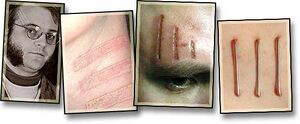Member bars: Difference between revisions
(Created page with "<html><div class="mw-content-ltr" dir="ltr" id="mw-content-text" lang="en"><p><br/> In the early days of the <a class="mw-redirect" href="/index.php?title=CoBM" title="CoBM">CoBMsome</a> ministers chose to tattoo themselves with three parallel white lines. The lines echoed naval uniforms and represented "mind, body, and soul". </p><p>Members (not ministers) were told they could show their allegiance by tattooing "member bars" — two parallel white lines. Few members did...") |
(Page conversion via llm-mediawiki-rev -jwm) |
||
| Line 1: | Line 1: | ||
In the early days of the [[CoBM|CoBMsome]] ministers chose to tattoo themselves with three parallel white lines. The lines echoed naval uniforms and represented "mind, body, and soul". | |||
In the early days of the | |||
Members (not ministers) were told they could show their allegiance by tattooing "member bars" — two parallel white lines. Few members did so, but soon enough one asked which bar they were missing; mind, body or soul? After this, '''minister bars''' became Church of Body Modification bars equally accessible to members and ministers alike. | |||
[[File:Minister_Bars-1.jpg|thumb|center]] | |||
In addition, the original "[[White ink|white ink]]" iconography didn't last long either, with some people choosing different colors of ink, scarification and implants, or even piercings to form the markings. The requirement of three equal parallel lines was also short-lived as members and ministers expressed these bars with their own personal style. | |||
Since the CoBM fell apart, many former members and ministers have tattooed over or otherwise obscured these marks. | |||
Latest revision as of 07:57, 17 September 2023
In the early days of the CoBMsome ministers chose to tattoo themselves with three parallel white lines. The lines echoed naval uniforms and represented "mind, body, and soul".
Members (not ministers) were told they could show their allegiance by tattooing "member bars" — two parallel white lines. Few members did so, but soon enough one asked which bar they were missing; mind, body or soul? After this, minister bars became Church of Body Modification bars equally accessible to members and ministers alike.
In addition, the original "white ink" iconography didn't last long either, with some people choosing different colors of ink, scarification and implants, or even piercings to form the markings. The requirement of three equal parallel lines was also short-lived as members and ministers expressed these bars with their own personal style.
Since the CoBM fell apart, many former members and ministers have tattooed over or otherwise obscured these marks.
